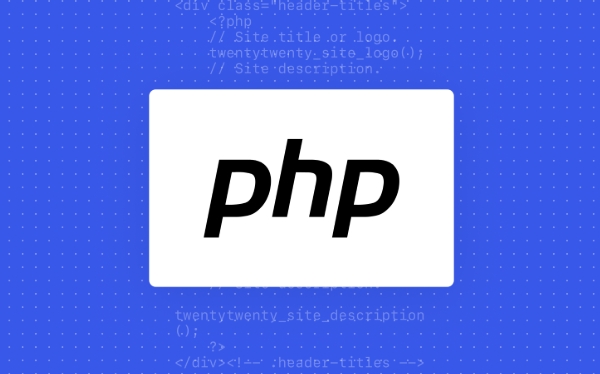The error "Cannot modify header information - headers already sent" appears because there is already output of content before trying to modify the header in PHP. 1. Check whether there are spaces or line breaks at the beginning of the PHP file, and make sure to start with <?php ; 2. Make sure that there is no output such as HTML or echo statements before the call of functions such as header(), session_start(); 3. Avoid unnecessary ?> tags and subsequent blanks at the end of the file; 4. Check whether the included files have introduced unexpected output, and you can use the ob_start() buffer to control the output.

When the error "Cannot modify header information - headers already sent" appears, it means that when you try to modify header information in PHP (such as using header() , setcookie() or session_start() ), the content has been output. The PHP header must be sent before any actual output, so once the output starts, it cannot be modified.

1. Check if there are spaces or output appears in front of <?php
This is one of the most common reasons. If your PHP file has blank lines, spaces or even newline characters at the beginning, it will be treated as output content.
// Error example: There is space or line break in front of it <?php session_start(); ?>
? The correct way to do this is to make sure your PHP file starts with <?php and does not have any characters in front of it, including blanks and comments.

- Use the code editor to view hidden characters (such as displaying whitespace characters)
- Delete all spaces and empty lines at the beginning of the file
- If you use the template structure, you should also pay attention to whether the main entry file starts cleanly
2. Check whether there is any content output before header() call
Sometimes it is not the beginning problem, but the content is output in advance somewhere in the middle. for example:
- Write HTML content directly
- Use
echo,print,var_dump - File containing a certain output content (such as debug statement not deleted)
<?php echo "Debug info"; // The content has been output here header('Location: /'); // So will this line report an error?>
? Solution:

- Put all
header()andsession_start()before the output logic - Avoid using debug output before these function calls
- You can use
ob_start()to start the buffer to delay output (suitable for complex projects)
3. Pay attention to the end of the file ?> Is it redundant
Many PHP files do not need to close the tag in the end ?> , especially pure PHP files. Because new lines or spaces after closing tags are also taken as output.
<?php // some code... ?>? ← This line break will be treated as output!
? Best Practices:
- Pure PHP file omitted
?>End tag - If you have to keep it, make sure there are no line breaks or spaces after it
4. Check whether the included files have introduced unexpected output
Sometimes the problem lies in your include or require file. for example:
- A configuration file accidentally hits an empty line
- There is a class file at the end of it
?>and it has a line break - There is debug output in third-party libraries
? Solution:
- Check the include files one by one
- Use
ob_get_contents()to see if there is any content in the buffer output in advance - Add
ob_start()at the top of the entry file to avoid such problems affecting the header
Basically, these common causes and solutions. Although this type of error seems simple, it may be a bit annoying to troubleshoot, especially when multiple files are nested in include in large projects. Keeping the code clean and familiar with the output process can reduce pitfalls.
The above is the detailed content of How to fix PHP header already sent error. For more information, please follow other related articles on the PHP Chinese website!

Hot AI Tools

Undress AI Tool
Undress images for free

Undresser.AI Undress
AI-powered app for creating realistic nude photos

AI Clothes Remover
Online AI tool for removing clothes from photos.

Clothoff.io
AI clothes remover

Video Face Swap
Swap faces in any video effortlessly with our completely free AI face swap tool!

Hot Article

Hot Tools

Notepad++7.3.1
Easy-to-use and free code editor

SublimeText3 Chinese version
Chinese version, very easy to use

Zend Studio 13.0.1
Powerful PHP integrated development environment

Dreamweaver CS6
Visual web development tools

SublimeText3 Mac version
God-level code editing software (SublimeText3)

Hot Topics
 How to combine two php arrays unique values?
Jul 02, 2025 pm 05:18 PM
How to combine two php arrays unique values?
Jul 02, 2025 pm 05:18 PM
To merge two PHP arrays and keep unique values, there are two main methods. 1. For index arrays or only deduplication, use array_merge and array_unique combinations: first merge array_merge($array1,$array2) and then use array_unique() to deduplicate them to finally get a new array containing all unique values; 2. For associative arrays and want to retain key-value pairs in the first array, use the operator: $result=$array1 $array2, which will ensure that the keys in the first array will not be overwritten by the second array. These two methods are applicable to different scenarios, depending on whether the key name is retained or only the focus is on
 How to use php exit function?
Jul 03, 2025 am 02:15 AM
How to use php exit function?
Jul 03, 2025 am 02:15 AM
exit() is a function in PHP that is used to terminate script execution immediately. Common uses include: 1. Terminate the script in advance when an exception is detected, such as the file does not exist or verification fails; 2. Output intermediate results during debugging and stop execution; 3. Call exit() after redirecting in conjunction with header() to prevent subsequent code execution; In addition, exit() can accept string parameters as output content or integers as status code, and its alias is die().
 Applying Semantic Structure with article, section, and aside in HTML
Jul 05, 2025 am 02:03 AM
Applying Semantic Structure with article, section, and aside in HTML
Jul 05, 2025 am 02:03 AM
The rational use of semantic tags in HTML can improve page structure clarity, accessibility and SEO effects. 1. Used for independent content blocks, such as blog posts or comments, it must be self-contained; 2. Used for classification related content, usually including titles, and is suitable for different modules of the page; 3. Used for auxiliary information related to the main content but not core, such as sidebar recommendations or author profiles. In actual development, labels should be combined and other, avoid excessive nesting, keep the structure simple, and verify the rationality of the structure through developer tools.
 How to create an array in php?
Jul 02, 2025 pm 05:01 PM
How to create an array in php?
Jul 02, 2025 pm 05:01 PM
There are two ways to create an array in PHP: use the array() function or use brackets []. 1. Using the array() function is a traditional way, with good compatibility. Define index arrays such as $fruits=array("apple","banana","orange"), and associative arrays such as $user=array("name"=>"John","age"=>25); 2. Using [] is a simpler way to support since PHP5.4, such as $color
 The requested operation requires elevation Windows
Jul 04, 2025 am 02:58 AM
The requested operation requires elevation Windows
Jul 04, 2025 am 02:58 AM
When you encounter the prompt "This operation requires escalation of permissions", it means that you need administrator permissions to continue. Solutions include: 1. Right-click the "Run as Administrator" program or set the shortcut to always run as an administrator; 2. Check whether the current account is an administrator account, if not, switch or request administrator assistance; 3. Use administrator permissions to open a command prompt or PowerShell to execute relevant commands; 4. Bypass the restrictions by obtaining file ownership or modifying the registry when necessary, but such operations need to be cautious and fully understand the risks. Confirm permission identity and try the above methods usually solve the problem.
 php raw post data php
Jul 02, 2025 pm 04:51 PM
php raw post data php
Jul 02, 2025 pm 04:51 PM
The way to process raw POST data in PHP is to use $rawData=file_get_contents('php://input'), which is suitable for receiving JSON, XML, or other custom format data. 1.php://input is a read-only stream, which is only valid in POST requests; 2. Common problems include server configuration or middleware reading input streams, which makes it impossible to obtain data; 3. Application scenarios include receiving front-end fetch requests, third-party service callbacks, and building RESTfulAPIs; 4. The difference from $_POST is that $_POST automatically parses standard form data, while the original data is suitable for non-standard formats and allows manual parsing; 5. Ordinary HTM
 How to handle File Uploads securely in PHP?
Jul 08, 2025 am 02:37 AM
How to handle File Uploads securely in PHP?
Jul 08, 2025 am 02:37 AM
To safely handle PHP file uploads, you need to verify the source and type, control the file name and path, set server restrictions, and process media files twice. 1. Verify the upload source to prevent CSRF through token and detect the real MIME type through finfo_file using whitelist control; 2. Rename the file to a random string and determine the extension to store it in a non-Web directory according to the detection type; 3. PHP configuration limits the upload size and temporary directory Nginx/Apache prohibits access to the upload directory; 4. The GD library resaves the pictures to clear potential malicious data.
 How Do You Pass Variables by Value vs. by Reference in PHP?
Jul 08, 2025 am 02:42 AM
How Do You Pass Variables by Value vs. by Reference in PHP?
Jul 08, 2025 am 02:42 AM
InPHP,variablesarepassedbyvaluebydefault,meaningfunctionsorassignmentsreceiveacopyofthedata,whilepassingbyreferenceallowsmodificationstoaffecttheoriginalvariable.1.Whenpassingbyvalue,changestothecopydonotimpacttheoriginal,asshownwhenassigning$b=$aorp






